The Health Education Assets Library (HEAL) is a collection of over 22,000 freely available digital materials for health sciences education. The collection is now housed at the University of Utah J. Willard Marriott Digital Library.
Filters: Collection: "ehsl_heal"
| Title | Description | Subject | Collection | ||
|---|---|---|---|---|---|
| 1 |
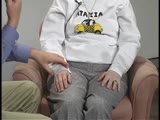 |
Coordination Exam: Abnormal Examples: Check Reflex (includes Spanish audio & captions) | The patient is unable to stop flexion of the arm on sudden release so the arm may strike the chest and doesn't recoil to the initial position. This is most likely due to failure of timely triceps contraction. NeuroLogic Exam has been supported by a grant from the Slice of Life Development Fund at th... | Coordination Examination; Check Reflex | NeuroLogic Exam: An Anatomical Approach |
| 2 |
 |
Coordination Exam: Abnormal Examples: Check Reflex (x2) (includes Spanish audio & captions) | The patient is unable to stop flexion of the arm on sudden release so the arm may strike the chest and doesn't recoil to the initial position. This is most likely due to failure of timely triceps contraction. NeuroLogic Exam has been supported by a grant from the Slice of Life Development Fund at th... | Coordination Examination; Check Reflex | NeuroLogic Exam: An Anatomical Approach |
| 3 |
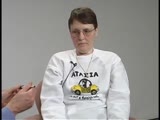 |
Coordination Exam: Abnormal Examples: Finger-to-nose (includes Spanish audio & captions) | Under (hypometria) and over (hypermetria) shooting of a target (dysmetria) and the decomposition of movement (the breakdown of the movement into its parts with impaired timing and integration of muscle activity) are seen with appendicular ataxia. NeuroLogic Exam has been supported by a grant from th... | Coordination Examination; Finger-to-nose Test | NeuroLogic Exam: An Anatomical Approach |
| 4 |
 |
Coordination Exam: Abnormal Examples: Finger-to-nose (x2) (includes Spanish audio & captions) | Under (hypometria) and over (hypermetria) shooting of a target (dysmetria) and the decomposition of movement (the breakdown of the movement into its parts with impaired timing and integration of muscle activity) are seen with appendicular ataxia. NeuroLogic Exam has been supported by a grant from th... | Coordination Examination; Finger-to-nose Test | NeuroLogic Exam: An Anatomical Approach |
| 5 |
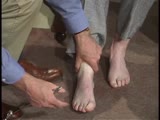 |
Coordination Exam: Abnormal Examples: Foot - Rapid Alternating Movements (includes Spanish audio & captions) | Movements are slow and irregular with imprecise timing of agonist and antagonist muscle action. NeuroLogic Exam has been supported by a grant from the Slice of Life Development Fund at the University of Utah, the Department of Pediatrics and the Office of Education at the University of Nebraska Medi... | Coordination Examination; Rapid Alternating Movements; Adiadochokinesis | NeuroLogic Exam: An Anatomical Approach |
| 6 |
 |
Coordination Exam: Abnormal Examples: Foot - Rapid Alternating Movements (x2) (includes Spanish audio & captions) | Movements are slow and irregular with imprecise timing of agonist and antagonist muscle action. NeuroLogic Exam has been supported by a grant from the Slice of Life Development Fund at the University of Utah, the Department of Pediatrics and the Office of Education at the University of Nebraska Medi... | Coordination Examination; Rapid Alternating Movements; Adiadochokinesis | NeuroLogic Exam: An Anatomical Approach |
| 7 |
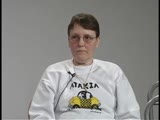 |
Coordination Exam: Abnormal Examples: Hand - Rapid Alternating Movements (includes Spanish audio & captions) | Movements are slow and irregular with imprecise timing. Inability to perform repetitive movements in a rapid rhythmic fashion is called dysdiadochokinesia. NeuroLogic Exam has been supported by a grant from the Slice of Life Development Fund at the University of Utah, the Department of Pediatrics an... | Coordination Examination; Dysdiadochokinesia | NeuroLogic Exam: An Anatomical Approach |
| 8 |
 |
Coordination Exam: Abnormal Examples: Hand - Rapid Alternating Movements (x2) (includes Spanish audio & captions) | Movements are slow and irregular with imprecise timing. Inability to perform repetitive movements in a rapid rhythmic fashion is called dysdiadochokinesia. NeuroLogic Exam has been supported by a grant from the Slice of Life Development Fund at the University of Utah, the Department of Pediatrics an... | Coordination Examination; Dysdiadochokinesia | NeuroLogic Exam: An Anatomical Approach |
| 9 |
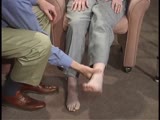 |
Coordination Exam: Abnormal Examples: Heel-to-shin (includes Spanish audio & captions) | The patient with ataxia of the lower extremity will have difficulty placing the heel on the knee with a side-to-side irregular over- and undershooting as the heel is advanced down the shin. Dysmetria on heel-to-shin can be seen in midline ataxia syndromes as well as cerebellar hemisphere disease so ... | Coordination Examination; Heel-shin Test | NeuroLogic Exam: An Anatomical Approach |
| 10 |
 |
Coordination Exam: Abnormal Examples: Heel-to-shin (x2) (includes Spanish audio & captions) | The patient with ataxia of the lower extremity will have difficulty placing the heel on the knee with a side-to-side irregular over- and undershooting as the heel is advanced down the shin. Dysmetria on heel-to-shin can be seen in midline ataxia syndromes as well as cerebellar hemisphere disease so ... | Coordination Examination; Heel-shin Test | NeuroLogic Exam: An Anatomical Approach |
| 11 |
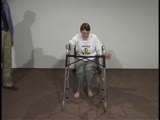 |
Coordination Exam: Abnormal Examples: Natural Gait (includes Spanish audio & captions) | Wide-based, unsteady, irregular steps with lateral veering| ataxia is most prominent when sudden changes are needed such as turning, standing up or stopping. NeuroLogic Exam has been supported by a grant from the Slice of Life Development Fund at the University of Utah, the Department of Pediatrics ... | Coordination Examination; Natural Gait | NeuroLogic Exam: An Anatomical Approach |
| 12 |
 |
Coordination Exam: Abnormal Examples: Natural Gait (x2) (includes Spanish audio & captions) | Wide-based, unsteady, irregular steps with lateral veering| ataxia is most prominent when sudden changes are needed such as turning, standing up or stopping. NeuroLogic Exam has been supported by a grant from the Slice of Life Development Fund at the University of Utah, the Department of Pediatrics ... | Coordination Examination; Natural Gait | NeuroLogic Exam: An Anatomical Approach |
| 13 |
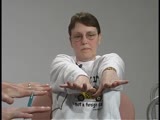 |
Coordination Exam: Abnormal Examples: Rebound (includes Spanish audio & captions) | Increased range of movement with lack of normal recoil to original position is seen in cerebellar disease. NeuroLogic Exam has been supported by a grant from the Slice of Life Development Fund at the University of Utah, the Department of Pediatrics and the Office of Education at the University of Ne... | Coordination Examination; Rebound | NeuroLogic Exam: An Anatomical Approach |
| 14 |
 |
Coordination Exam: Abnormal Examples: Rebound (x2) (includes Spanish audio & captions) | Increased range of movement with lack of normal recoil to original position is seen in cerebellar disease. NeuroLogic Exam has been supported by a grant from the Slice of Life Development Fund at the University of Utah, the Department of Pediatrics and the Office of Education at the University of Ne... | Coordination Examination; Rebound | NeuroLogic Exam: An Anatomical Approach |
| 15 |
 |
Coordination Exam: Abnormal Examples: Speech - Rapid Alternating Movements - Dysarthria (includes Spanish audio & captions) | Impaired speech articulation of cerebellar origin is characterized by being slow, indistinct, and scanning (scanning refers to decomposition of words into monosyllabic parts and loss of normal phrasing and intonation). NeuroLogic Exam has been supported by a grant from the Slice of Life Development ... | Coordination Examination | NeuroLogic Exam: An Anatomical Approach |
| 16 |
 |
Coordination Exam: Abnormal Examples: Speech - Rapid Alternating Movements - Dysarthria (x2) (includes Spanish audio & captions) | Impaired speech articulation of cerebellar origin is characterized by being slow, indistinct, and scanning (scanning refers to decomposition of words into monosyllabic parts and loss of normal phrasing and intonation). NeuroLogic Exam has been supported by a grant from the Slice of Life Development ... | Coordination Examination | NeuroLogic Exam: An Anatomical Approach |
| 17 |
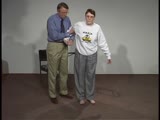 |
Coordination Exam: Abnormal Examples: Station (includes Spanish audio & captions) | Patient's feet will be placed wider apart then usual in order to maintain balance (broad or wide-based station). Midline ataxias cause instability of station with eyes opened or closed. NeuroLogic Exam has been supported by a grant from the Slice of Life Development Fund at the University of Utah, t... | Coordination Examination; Station | NeuroLogic Exam: An Anatomical Approach |
| 18 |
 |
Coordination Exam: Abnormal Examples: Station (x2) (includes Spanish audio & captions) | Patient's feet will be placed wider apart then usual in order to maintain balance (broad or wide-based station). Midline ataxias cause instability of station with eyes opened or closed. NeuroLogic Exam has been supported by a grant from the Slice of Life Development Fund at the University of Utah, t... | Coordination Examination; Station | NeuroLogic Exam: An Anatomical Approach |
| 19 |
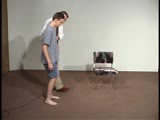 |
Coordination Exam: Abnormal Examples: Tandem Gait (includes Spanish audio & captions) | Patients with ataxia have difficulty narrowing the station in order to walk heel to toe. Tandem gait is helpful in identifying subtle or mild gait ataxia. NeuroLogic Exam has been supported by a grant from the Slice of Life Development Fund at the University of Utah, the Department of Pediatrics and... | Coordination Examination; Tandem Gait; Heel-toe Gait | NeuroLogic Exam: An Anatomical Approach |
| 20 |
 |
Coordination Exam: Abnormal Examples: Tandem Gait (x2) (includes Spanish audio & captions) | Patients with ataxia have difficulty narrowing the station in order to walk heel to toe. Tandem gait is helpful in identifying subtle or mild gait ataxia. NeuroLogic Exam has been supported by a grant from the Slice of Life Development Fund at the University of Utah, the Department of Pediatrics and... | Coordination Examination; Tandem Gait; Heel-toe Gait | NeuroLogic Exam: An Anatomical Approach |
| 21 |
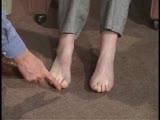 |
Coordination Exam: Abnormal Examples: Toe-to-finger (includes Spanish audio & captions) | Same as finger-to-nose except for the lower extremities. For both the upper and lower extremities, it is important to always compare right versus left. NeuroLogic Exam has been supported by a grant from the Slice of Life Development Fund at the University of Utah, the Department of Pediatrics and th... | Coordination Examination; Toe-to-finger Test | NeuroLogic Exam: An Anatomical Approach |
| 22 |
 |
Coordination Exam: Abnormal Examples: Toe-to-finger (x2) (includes Spanish audio & captions) | Same as finger-to-nose except for the lower extremities. For both the upper and lower extremities, it is important to always compare right versus left. NeuroLogic Exam has been supported by a grant from the Slice of Life Development Fund at the University of Utah, the Department of Pediatrics and th... | Coordination Examination; Toe-to-finger Test | NeuroLogic Exam: An Anatomical Approach |
| 23 |
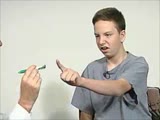 |
Coordination Exam: Abnormal Examples: Tremor (includes Spanish audio & captions) | A cerebellar intention tremor (1st scene in this movie) arises mainly from limb girdle muscles and is maximal at the most demanding phase of the active movement. This must be distinguished from a postural tremor (fine distal 8-13 Hz)(2nd scene) or resting tremor (coarse distal 5-6 Hz pill-rolling ty... | Coordination Examination; Intention Tremor; Static Tremor; Resting Tremor | NeuroLogic Exam: An Anatomical Approach |
| 24 |
 |
Coordination Exam: Abnormal Examples: Tremor (x2) (includes Spanish audio & captions) | A cerebellar intention tremor (1st scene in this movie) arises mainly from limb girdle muscles and is maximal at the most demanding phase of the active movement. This must be distinguished from a postural tremor (fine distal 8-13 Hz)(2nd scene) or resting tremor (coarse distal 5-6 Hz pill-rolling ty... | Coordination Examination; Intention Tremor; Static Tremor; Resting Tremor | NeuroLogic Exam: An Anatomical Approach |
| 25 |
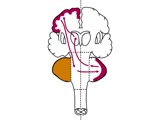 |
Coordination Exam: Anatomy: Cerebrocerebellum (includes Spanish audio & captions) | The 3rd subdivision of the cerebellum is the cerebrocerebellum. This system consists of connections from the cerebral cortex (predominantly motor) to the cerebellar hemispheres then back to the cerebral cortex. This system is important in motor planning. Dysfunction of the cerebellar hemispheres res... | Coordination Examination | NeuroLogic Exam: An Anatomical Approach |
